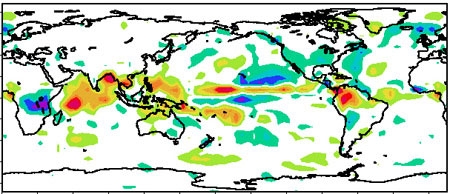As Predicted, Global Warming Fuels More Tropical Rainfall

Scientists had predicted that global warming ought to increase rainfall in the tropics. Now NASA researchers say it has.
Scientists assembled a 27-year global record of rainfall from satellite observations and ground-based instruments and found that the rainiest years between 1979 and 2005 occurred primarily after 2001.
The wettest year in the record was 2005, followed by 2004, 2003, 2002 and 1998.
The patterns observed in the record showed that increases in rainfall were concentrated over tropical oceans, while there was a slight decrease over land.
"When we look at the whole planet over almost three decades, the total amount of rain falling has changed very little," said study leader Guojun Gu of NASA's Goddard Space Flight Center in Greenbelt, Md. "But in the tropics, where nearly two-thirds of all rain falls, there has been an increase of 5 percent."
This increase in rainfall is expected in a warming world, because warmer surface temperatures increase the evaporation of water from the ocean and the land and warmer air can hold more moisture, which eventually forms clouds and precipitation.
"A warming climate is the most plausible cause of this observed trend in tropical rainfall," said study team member Robert F. Adler, also of Goddard.
Get the world’s most fascinating discoveries delivered straight to your inbox.
Evidence for the trend is still being gathered, Adler says. The latest numbers for 2006 show that it tied 2005 as the rainiest year in the record.
The results of the study are detailed in the Aug. 1 issue of the Journal of Climate.
- Video: Tropical Rainfalls Rising
- Top 10 Surprising Results of Global Warming
- Weather 101: All About Wind and Rain

Andrea Thompson is an associate editor at Scientific American, where she covers sustainability, energy and the environment. Prior to that, she was a senior writer covering climate science at Climate Central and a reporter and editor at Live Science, where she primarily covered Earth science and the environment. She holds a graduate degree in science health and environmental reporting from New York University, as well as a bachelor of science and and masters of science in atmospheric chemistry from the Georgia Institute of Technology.


